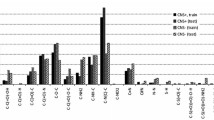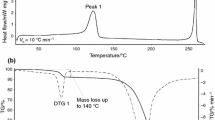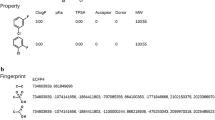Abstract
The supervised pattern recognition methods K-Nearest Neighbors (KNN), stepwise discriminant analysis (SDA), and soft independent modelling of class analogy (SIMCA) were employed in this work with the aim to investigate the relationship between the molecular structure of 27 cannabinoid compounds and their analgesic activity. Previous analyses using two unsupervised pattern recognition methods (PCA—principal component analysis and HCA—hierarchical cluster analysis) were performed and five descriptors were selected as the most relevants for the analgesic activity of the compounds studied: R 3 (charge density on substituent at position C3), Q 1 (charge on atom C1), A (surface area), log P (logarithm of the partition coefficient) and MR (molecular refractivity). The supervised pattern recognition methods (SDA, KNN, and SIMCA) were employed in order to construct a reliable model that can be able to predict the analgesic activity of new cannabinoid compounds and to validate our previous study. The results obtained using the SDA, KNN, and SIMCA methods agree perfectly with our previous model. Comparing the SDA, KNN, and SIMCA results with the PCA and HCA ones we could notice that all multivariate statistical methods classified the cannabinoid compounds studied in three groups exactly in the same way: active, moderately active, and inactive.






Similar content being viewed by others
References
Roger GP (2006) Br J Pharmacol 147:S163. doi:10.1038/sj.bjp.0706406
Roger GP (2004) Euphytica 140:73. doi:10.1007/s10681-004-4756-9
Tiziano T, Píer LF, Clementina M, Gabriella O, Giuseppe S, Adriano M (2006) J Med Chem 49:984. doi:10.1021/jm050875u
Carl RL, Arthur CR, Alexander FH (2004) Br J Pharmacol 143:227. doi:10.1038/sj.bjp.0705931
Honório KM, da Silva ABF (2005) J Mol Model 11:200. doi:10.1007/s00894-005-0243-z
Arroio A, Honório KM, da Silva ABF (2004) J Mol Struct THEOCHEM 709:223. doi:10.1016/j.theochem.2003.10.079
Romeder JM (1973) Methode Programme d’analyse Discriminante. Dunod, Paris
Kowalski BR, Bender CF (1972) J Am Chem Soc 94:5632. doi:10.1021/ja00771a016
Wold S (1976) Pattern Recognit 8:127. doi:10.1016/0031-3203(76)90014-5
Molfetta FA, Honório KM, Alves CN, da Silva ABF (2004) J Mol Struct THEOCHEM 674:191. doi:10.1016/j.theochem.2003.12.007
Mechoulam R (1973) Marijuana: chemistry, pharmacology, metabolism and clinical effects. Academic Press, New York
Petersen RC (1980) Marijuana research findings.. Department of Health and Human Services, Maryland
Mechoulam R (1970) Science 168:1166. doi:10.1126/science.168.3936.1159
da Silva ABF, Trsic M (1995) J Mol Struct 356:256. doi:10.1016/0022-2860(95)08959-Y
Razdan RK (1986) Pharmacol Rev 38:49
Dewar MJ, Zoebisch EG, Healy EF, Stewart JJP (1985) J Am Chem Soc 107:3902. doi:10.1021/ja00299a024
Beebe KR, Pell RJ, Seasholtz MB (1998) Chemometrics: a practical guide. Wiley-Interscience, New York
INFOMETRIX. Pirouettte Multivariate Data analysis form IBM PC Systems, Version 2.02. Seattle, WA, 1990-1996
STATSOFT INC. Statistica 4.3 Tulsa, 1993
Souza J Jr, Molfetta FA, Honório KM, Santos RHA, da Silva ABF (2004) J Chem Inf Comput Sci 44:1153. doi:10.1021/ci030384n
Gardiner WP (1997) Statistical Analysis Methods for Chemists. Royal Society Chemistry, Cambridge
Weber KC, Honório KM, Bruni AT, da Silva ABF (2006) J Mol Model 12:915. doi:10.1007/s00894-005-0083-x
Ferreira MMC (2002) J Braz Chem Soc 13:742
Clark RD (2004) J Mol Graph Model 22:487. doi:10.1016/j.jmgm.2004.03.009
Sharaf MA, Illman DL, Kowalski BR (1986) Chemometrics. Wiley, New York
Brereton RG (1992) Multivariate pattern recognition in chemometrics, illustrated by case studies. Elsevier, Amsterdam
Acknowledgments
The authors would like to thank FAPESP and CNPq (Brazilian agencies) for the financial support.
Author information
Authors and Affiliations
Corresponding author
Rights and permissions
About this article
Cite this article
Arroio, A., Lima, E.F., Honório, K.M. et al. A chemometric study on the analgesic activity of cannabinoid compounds using SDA, KNN and SIMCA methods. Struct Chem 20, 577–585 (2009). https://doi.org/10.1007/s11224-009-9437-9
Received:
Accepted:
Published:
Issue Date:
DOI: https://doi.org/10.1007/s11224-009-9437-9




